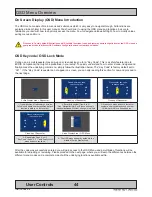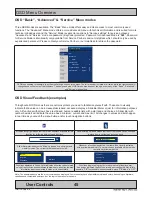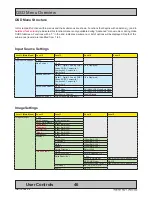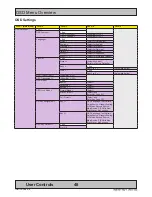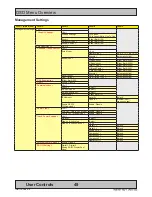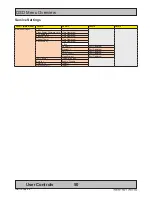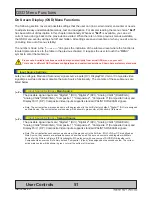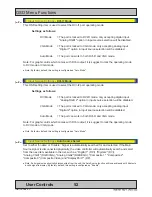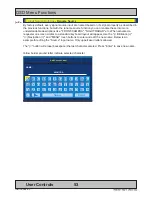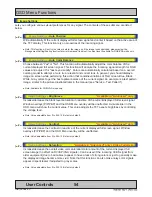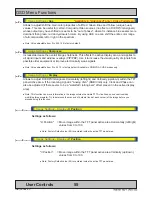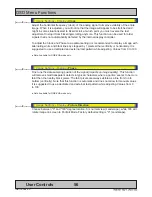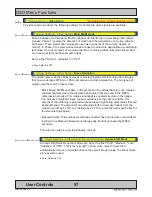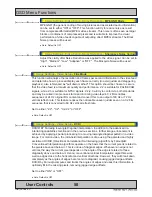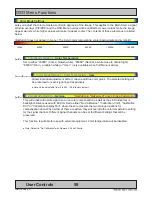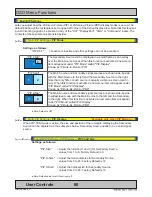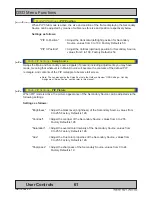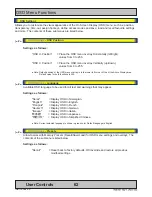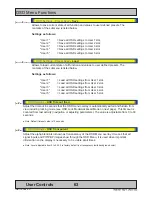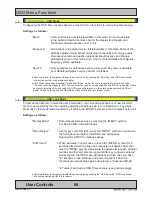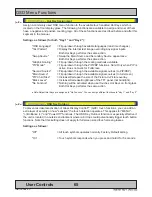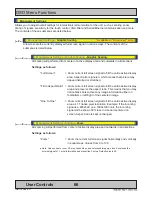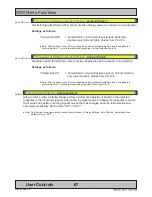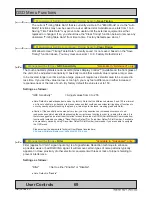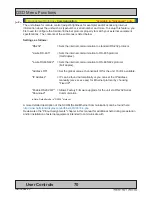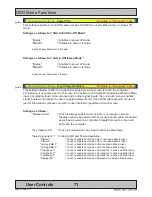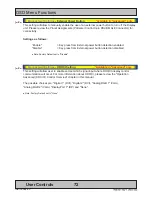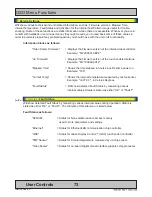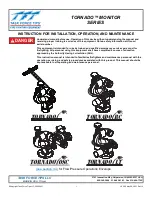
58
User Controls
IND100064-55
|-------------4-------------
Image Settings - Video Setup - Noise Reduction
- MPEG NR Mode
MPEG NR (the generic coding of moving pictures and associated audio information)
can be set to either "ON" or "OFF". This function will try to reduce noise as result
from compressed/formatted MPEG video streams. This noise is often seen as larger
blocks or containers of compressed pixels and is suitable to improve the visual
performance of video feeds capable of outputting direct MPEG streams. The Block
Noise process will be used.
● Note: Default is OFF
|-------------4-------------
Image Settings - Video Setup - Noise Reduction
- Sharpness Noise Coring
Adjust the clarity after Noise Reduction was applied to the video signal. Can be set to
"High", "Medium", "Low", "Adaptive" or "OFF". The Mosquito Noise will be used.
● Note: Default is OFF
|--------3--------
Image Settings - Video Setup
- Film Mode
This function will analyze the resolution and frames per second information in the video feed
and determine how to process/display each frame correctly (to avoid judder and staggering
playback), also referenced as "pull down method". This option should be chosen to secure
that the video feed is at maximum quality and performance. 2:2 is suitable for PAL/SECAM
signals, while 2:3 is suitable for NTSC signals. 2:2-2:3 will try to conform to both standards
and may be suited in some cases for mixed incoming video feeds. 3:2 film enables
sequences of 24 Hz original film content and convert this to an output of 48 Hz or 72 Hz
vertical refresh rate. This feature reduces the noticeable uneven judder seen on a 3:2 film
sequence that is converted to 60 Hz vertical refresh rate.
Set to either; "2:2", "3:2", "3:2-2:2" or "OFF".
● Note: Default is OFF
|--------3--------
Image Settings - Video Setup
- DCDi
DCDI® BY Faroudja low-angle Diagonal interpolation. In addition to the advanced de-
interlacing capabilities mentioned in the previous sections, further image enhancement is
achieved by applying special processing to a moving lowangle diagonal pattern in a video
image. For motion video, the intra-field interpolation is done using the patented and highly
acclaimed DCDI® (Directional Correlational De-Interlacing) algorithm by Faroudja®.
Conventional Interpolation algorithms operate on the basis that the current pixel is related to
the pixels above and below it. This is untrue of diagonal edges. Whenever an edge is not
vertical, the way the current pixel depends on the angle of the edge is related to those
diagonally above and below it. Hence, conventional vertical Interpolation algorithms work
well on edges close to the horizontal and vertical directions. However, they will break down
completely as the angles of edges become more diagonal, causing jagged edge artifacts.
DCDi® by Faroudja computes and tracks the angles of edges and uses this information to
optimally fill in the missing pixels, removing jagged edge artifacts.
Set to either "ON" or "OFF".
● Note: Default is OFF
OSD Menu Functions
Summary of Contents for HD 15T22 MMD-xxx-F series
Page 10: ...10 This page left intentionally blank...
Page 11: ...11 General...
Page 20: ...20 This page left intentionally blank...
Page 21: ...21 Installation...
Page 40: ...40 This page left intentionally blank...
Page 41: ...41 Operation...
Page 75: ...75 Operation Advanced DDC CI...
Page 78: ...78 This page left intentionally blank...
Page 79: ...79 Specifications...
Page 90: ...90 This page left intentionally blank...
Page 91: ...91 Technical Drawings...
Page 102: ...102 This page left intentionally blank...
Page 103: ...103 Technical Drawings Accessories...
Page 142: ...142 This page left intentionally blank...
Page 143: ...143 Appendixes...
Page 153: ...153 Appendix IND100077 24 User Notes...
Page 155: ...155 Revision History Appendix IND100077 170...
Page 156: ...www hatteland display com...

